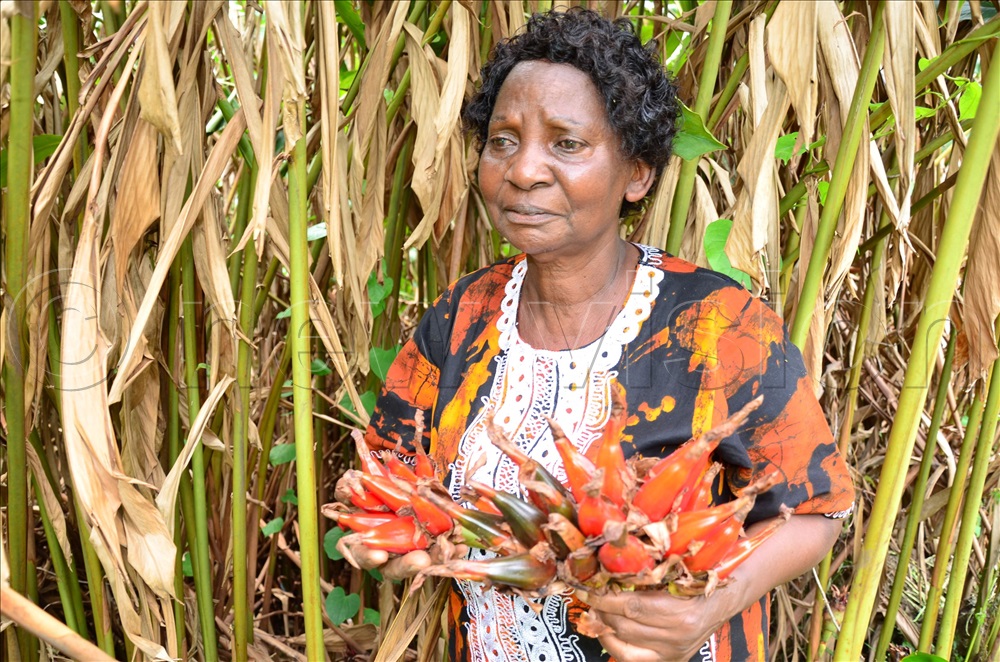By Umar Nsubuga
Wild ginger, also known as African ginger (Siphonochilus aethiopicus), is a valuable plant that farmers can benefit from in several ways.
It is prized for its medicinal, culinary, and aromatic properties, making it a good crop for small-scale and commercial farmers.
Evanice Manyiraho, a wild ginger farmer in Kicwamba in Kabarole district says wild ginger is widely known for its medicinal properties. It’s used to treat colds, headaches, digestive issues, and respiratory problems. The demand for natural herbal remedies is growing, making wild ginger a potentially profitable crop.
She says farmers can sell wild ginger to herbal medicine producers, local markets, and pharmaceutical industries. Its root rhizomes are highly valued in herbal medicines and natural supplements. If processed or dried, wild ginger can fetch higher prices.

She also says that in some cultures, wild ginger is used as a spice or flavouring in food and beverages. Farmers can market it to gourmet chefs or restaurants that focus on organic and exotic ingredients.
“Wild ginger can be used for soil conservation and as an undergrowth plant in agroforestry systems, improving soil health. It also attracts pollinators, benefiting surrounding crops,” she says.
By processing wild ginger into herbal teas, powders, or essential oils, Manyiraho explains that farmers can enhance the market value of their produce and access new markets in health and wellness.
How to grow wild ginger
Manyiraho says wild ginger thrives in shady, moist environments. It can grow well under the canopy of trees, making it ideal for agroforestry systems. Choose a site with good drainage and protection from direct sunlight.
He adds that wild ginger prefers well-drained, fertile soil rich in organic matter. Loosen the soil to improve drainage and add compost or organic mulch to boost fertility. A slightly acidic to neutral pH (5.5–6.5) is ideal for growth.
Propagation
According to Manyiraho, the most common method of propagation is through rhizome division. Cut rhizomes into pieces, ensuring each piece has a growing bud or “eye.” Plant them about 5 cm deep in the soil.
Though less common, wild ginger can also be propagated by seeds.
However, she says seed germination may be slow and less reliable than rhizome division.
Planting
Plant rhizomes horizontally with the buds facing upward.
Space the rhizomes about 30 cm apart to give them room to spread and grow, she says.
Keep the soil consistently moist but not waterlogged.
“Mulch the planting area with organic materials like straw or leaves to conserve moisture and suppress weeds. Mulching also helps maintain the cool, shady conditions that wild ginger prefers,” she says adding that wild ginger requires regular watering, especially during dry periods. Keep the soil consistently damp, but avoid overwatering to prevent root rot.
Weeding and pest control
Control weeds by applying mulch or hand-weeding. Manyiraho explains that wild ginger is relatively pest-resistant, but keep an eye out for slugs or snails that might damage the leaves.
Harvesting
According to Manyiraho, wild ginger can be harvested after 2 to 3 years when the rhizomes are fully developed.
She says a farmer should carefully dig up the rhizomes, clean them, and allow them to dry in a shaded area before selling or processing.
To increase the value, she advises farmers can dry it to make powder or extract essential oils from the ginger rhizomes. This makes the product more marketable for medicinal and aromatic purposes.





